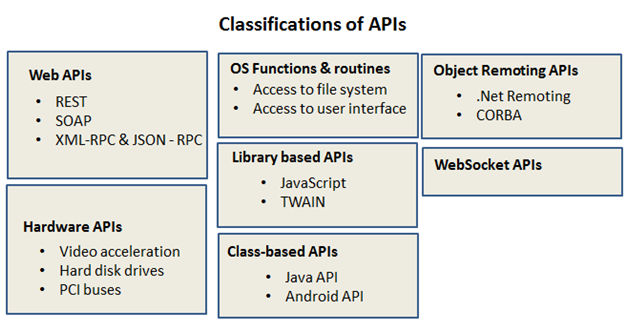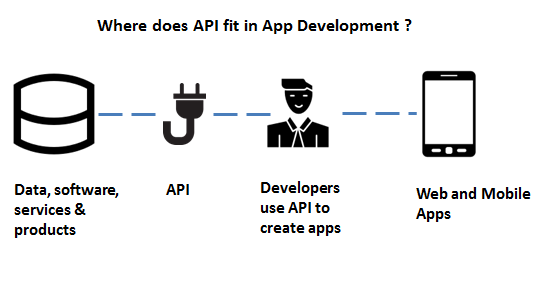Exploring Types of Web API for Web App Development
In
this generation of digital transformations, analytics, social, cloud, IoT and
mobile are the five major technologies that highlight the digital spectrum
today. Observing this spectrum closely, we find that there is a key thread,
which binds all these ideas together. Can you guess what that is? This thread
is known as API (Application Programming Interface). Today API is integrated
with everything, including mapping, payments, weather and whatever services you
need.
What is an API?
API
is a set of protocols and definitions, which allow technology services and
products to interact with each other establishing a common interface.
Well-designed APIs can make application development simple and speed up the
process. APIs support developers to add advanced features and capabilities to
the applications, which add extended functionalities. For instance, if an
enterprise wants to build machine learning capability like automatic image
tagging to its app, it can use a machine learning API.
API enables developers to integrate any two sections of an app or an isolated app. It includes various elements like protocols, functions, and tools, which enable developers to create apps. The key goal of all sorts of APIs is to stimulate the application development process by offering out-of-box functionalities. There are APIs for all sorts of systems, including libraries, OS and the web. Here is the classification of APIs:

Among
those APIs, web APIs has experienced an exponential increase in usage and popularity
in the past few years. Today, they are an important tool for web app
development. Although Web APIs are available for several different types of
industries, they are widely used in categories like mapping, social networking,
music, and shopping.
Web APIs for Web App Development
There are two popular methods to develop web apps. One is the traditional and true method of integrated web app development using web frameworks like Laravel, CodeIgniter, ASP.net, Rails or similar. Developing apps via frameworks focused to make the programming tasks simple as well as easily repeatable. However, most developers consider this method as monolithic. Another new philosophy that gains popularity in web app development is the use of an API-driven model. This approach utilizes a wide range of nodes connected to the API, which enables direct connection to the database for data access.
 The
tight integration in the framework approach causes dependency issues; hence,
many developers opt for APIs, which help in segmenting components in a better
way. In addition, the mobile application revolution also leads the way of the
era we are in now, where Web APIs are powering most apps.
The
tight integration in the framework approach causes dependency issues; hence,
many developers opt for APIs, which help in segmenting components in a better
way. In addition, the mobile application revolution also leads the way of the
era we are in now, where Web APIs are powering most apps.
Web APIs are a medium or an interface to enable pathways of communication between a company and its applications. This ensures that the digital assets of the company to be accessible to any channel. In Web APIs, communication takes place through web-specific protocols and the internet. The API itself requests messages, defines endpoints and response structure. You can build web APIs with ASP.net core, PHP and various other programming languages. Web APIs support developers in creating apps, which are compatible with any device and any browser.
 API
acts as a gateway to the asset and enables an entry point to the app developer
who will employ the asset for app development. It results in an app that is
connected to the services and data. Eventually, API enables the apps to ensure a
more intelligent user experience to the end-user.
API
acts as a gateway to the asset and enables an entry point to the app developer
who will employ the asset for app development. It results in an app that is
connected to the services and data. Eventually, API enables the apps to ensure a
more intelligent user experience to the end-user.
With Web APIs, they can access almost all features of HTTP like request/response headers, URIs, caching, content formatting, etc. There are types of Web APIs for web application development including REST, SOAP and RPC.
REST (Representational State Transfer)
REST is a Web API, which supports the development of enterprise-grade web apps. The introduction of a REST protocol for data management and exchange in internet service entirely revolutionized application development nearing the millennia. Almost every application includes a REST API. It involves a series of architectural styles and guidelines used for data transmission.
REST
API commonly applies for web application development but can also pass data to
software. This API employs the HTTP
standard to function with resources like TRACE, CONNECT, POST, GET, DELETE, and
PATCH. It serves as an interface between the systems to acquire data as well as
performs operations on data in different format like JSON, YAML, HTML, and XML.
The main reason why it becomes a prevailing choice for creating custom web
application these days is its simpler data processing solution. Laravel, Django, Express.js, Flask, and SpringBoot
are some best frameworks widely used to build REST API. Several web development
companies including .Net Development Company develop their apps with Rest API. Brands like Twitter and Expedia are
using this Web API to enhance their app performance.
Benefits of REST Web APIs
· It demands minimum bandwidth to create web applications
· REST API is optimized for web applications
· It includes simple guidelines to follow, which ensures effortless app building
· Involves single Uniform Interface
SOAP (Simple Object Access Protocol)
In the current software industry, SOAP is being widely used in legacy systems. SOAP is an XML based Web API for accessing web services using HTTP. The core objective of this web API is to ensure the security of transmitted data of your web application. SOAP is a method to send an XML request using the HTTP protocol and in turn, getting an XML response.
This communication protocol is designed to work in a decentralized environment to handle the interaction between request & response messages of web applications. SOAP uses all possible transport protocols, including SMTP and HTTP. The HTTP supports the SOAP model to easily tunnel across proxies and firewalls without any changes to the SOAP protocol. SOAP is a platform & a language-independent protocol. SOAP supports security, addressing and format independence through the concept of the routing message via a string of nodes.
In
addition, it includes built-in error handling. It supports automation when
involving in certain language products. As a result, SOAP web APIs becomes the
ideal choice for generating CRM solutions,
Payment gateway apps, telecommunication services, and identity management. For
instance, Salesforce
offers both a SOAP API and a REST API; as such, Salesforce developers
can integrate Salesforce with their platform in a way, which assist them the
best.
Benefits of SOAP Web APIs
RPC (Remote Procedure Call) API· Offers significant pre-build extensibility
· Platform, language, and transport-independent
· Includes built-in error handling
· It is determined by the functions
· Works on XML, which support various graphs, images,numbers, charts, texts, etc
RPC
API is the oldest as well as the simplest client-server protocol for web APIs.
This API is widely used for commands or procedure and it is gaining popularity
in the space of crypto-currency. This Web API is primarily used for generating
distributed, client-server-based applications. RPC can be used through other
transport protocols like AMQP. RPC API is available in two types:
· XML RPC API – Remote procedure protocol uses HTTP as a transport mechanism and XML for encoding its call
· JSON-RPC API – This API works like the XML RPC API but encoded in JSON
XML RPC defines only a few commands and data types, whereas JSON RPC enables for multiple calls and notifications that to be transferred to the server.
RPC
Web APIs are well known as the subroutine or function call in which one client
or program requests for data from the server & the server sends the
response to the client. Slack uses the RPC Web API since most of the
functionalities it is working on won’t fit into the REST Web API seamlessly. Monero
a private Digital Currency also comprises an RPC protocol. Similarly, Ethereum,
an open-source platform for decentralized apps uses a JSON RPC protocol.
Benefits of RPC Web APIs
· RPC is deterministic as it functions with arguments & returned values
· RPC comes with IDL; hence, it is easy to validate input
· RPC Web APIs are faster because of direct API calls rather than RESTful calls
· It is an ideal option for producing CRUD (Create, Read, Update, and Delete) action on your web applications
· In RPC API, only Get and Post is used to adjust the information
Choosing Right API for your Project
By understanding the types of Web APIs, the next major decision that you should make is which API to choose for your project. Picking the wrong API could be a time-sink – it can you lock you with the limited features of APIs. On the other hand, using the right API can ensure ready service, flawless security, collaboration, automation and many more.
Hence, making the right decision is important and there are several things to consider in determining the best one in the market. Efficiency, integration, customized user experiences, information sharing, support, and community are a few attributes that shouldn’t be ignored.
Overall,
Web APIs are responsible for nearly everything you do with just a few clicks.
Almost all web applications today operate with some kind of internet
connectivity and involve interaction with APIs or web services. While understanding what a web API is and
what its types are, is fairly simple and straightforward, the process of
choosing the right type to build your web application and then designing it to
function effectively is vital to offer your web API a long life. Hence, realizing
the benefits of these web APIs can be substantially helpful when you are
planning a new app.
Post Your Ad Here
Comments